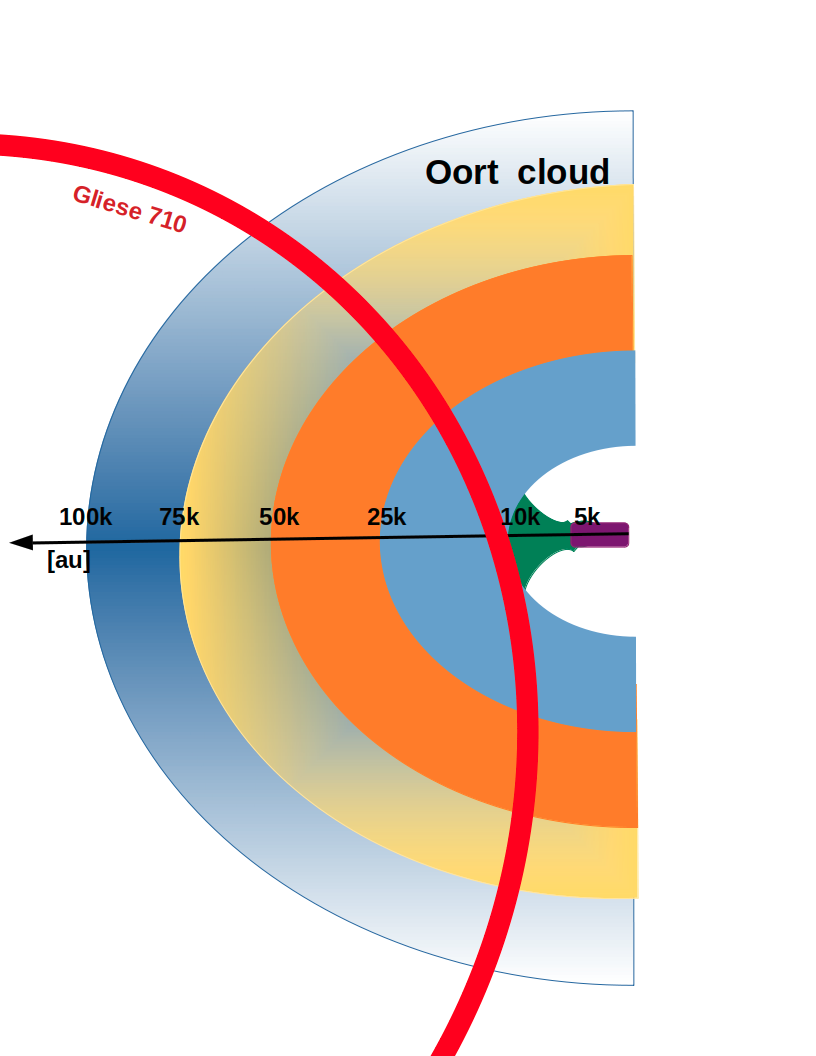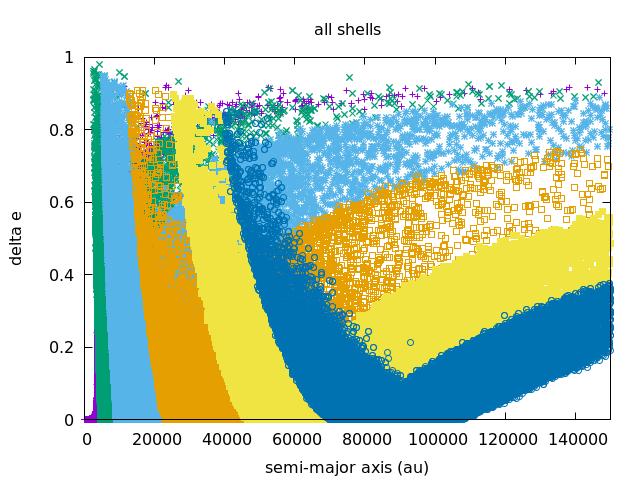Perturbations of trans-Neptunian objects due to Gliese 710’s passage
- 1Department of Astrophysics, University of Vienna, Türkenschanzstrasse 17, A-1180 Wien, Austria
- 2IMCCE, Observatoire de Paris, univ. PSL, CNRS, Sorbonne univ., univ. Lille, 77 Av. Denfert Rochereau, F-75014 Paris, France
Introduction:
Gaia observations (DR1-DR3) confirmed that the solar system will experience a close flyby of the K-type star Gliese 710 in about 1.3 Myrs. This 0.6 solar mass star will pass through the Oort cloud at a velocity of ~14.4 km/s, an inclination of ~150° with respect to the ecliptic and approach the Sun up to approximately 10,000 au (according to Gaia DR3 release). Earlier studies predicted flyby distances between 12000 and 4300 au (see e.g. Berski and Dybczynski 2016; Bailer-Jones et al. 2018; De la Fuente Marcos and De la Fuente Marcos 2018). The stellar passage will perturb the comets outside Neptune’s orbit, especially
objects entering the sphere of influence of Gliese 710.
Assuming that there are 10¹² Oort cloud objects between 100 to 100000 au from the Sun (resulting in a mean object density of 0.0002 comets/au³), it is obvious that numerical calculations of such a system are not within the realms of possibility even if a numerical code allows orbit calculation of tens of millions of (non-interacting) objects.
Numerical study:
Using our recently developed GPU based N-body code GANBISS (Zimmermann & Pilat-Lohinger 2023) we studied the orbits of some hundred million test-comets in the outer solar system for the time of the flyby of Gliese 710 which takes about 64000 years. 50 million comets were distributed in each of the six zones around the hyperbolic trajectory of the passing star. The cross section of this (red) tube is defined by the sphere of influence of Gliese 710. Figure 1 shows the six zones of the Oort cloud: a flat disk (purple) from 50 to 5000 au (i < 1°), a flared disk (green) from 5000 to 10000 au (i < 45°) and a spherical cloud between 10000 and 100000 au (0° < i < 180°) which has been divided into four zones.
Results:
When looking at the changes in the orbital parameters of the comets due to the stellar flyby in the individual zones, the (a,e) diagrams show V-structures (see Pilat-Lohinger et al. 2022a, 2022b) that disappear when the entire area of the Oort cloud is considered at once.
The passage of a star thus produces two branches of comets: an inward-facing branch that can transport comets towards the inner solar system, and an outward-facing branch that might scatter objects into the interstellar region. Moreover, the inward-facing branch shows higher eccentricities than the outward-facing branch, particularly in case of comets of the outer spherical cloud.
Assuming that the radius of Gliese 710's sphere of influence is about 2000 au -- resulting in an average object density of 0.00017 obj/au3 in the tube around the trajectory -- our calculations show that after the stellar flyby more than 4500 comets have their pericenter within 5 au and more than 108 million comets were scattered into interstellar space.
Conclusion:
Our numerical study shows that the star Gliese 710 -- which will pass through the Oort Cloud up to a distance of 10000 au from the Sun in about 1.3 million years -- will scatter several thousand comets towards the inner solar system, increasing the number of comets crossing Earth’s orbit and the risk of encounters with planet Earth.

Figure 1: Sketch of Gliese 710's flyby

Figure 2: Semi-major axis – eccentricity map of the comets after the stellar flyby. The different colors denote the different zone (see Fig.1). Note that the map shows a reduced number of comets.
How to cite: Pilat-Lohinger, E., Loibnegger, B., Zimmermann, M., Hestroffer, D., Fouchard, M., and Saillenfest, M.: Perturbations of trans-Neptunian objects due to Gliese 710’s passage, Europlanet Science Congress 2024, Berlin, Germany, 8–13 Sep 2024, EPSC2024-1358, https://doi.org/10.5194/epsc2024-1358, 2024.